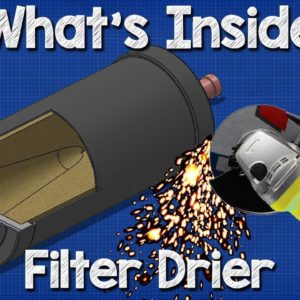Hey there guys, Paul here from TheEngineeringMindset.com. In this video, we're going to be looking inside one of these, the hermetic filter drier by Danfoss. Coming up. What are they used for? Where do we find them? And then we'll cut one open, and look at all the parts inside, and discuss the purpose of each bit. If, by the end of this video, you still haven't had your
fill of filter driers, then I suggest you head
over to Danfoss Learning and dive into their
collection of free eLessons. Danfoss is passionate
about sharing knowledge, so in addition to sponsoring this video, they've also made hundreds of eLessons available for free on their website, including multiple
courses on filter driers. You can find all of it
by following the link in the video description down below. Where do we find these filter driers? This is a very typical model filter drier, and we'll find these
installed in the liquid line of the refrigeration system between the condenser
and the expansion valve.
We've covered how expansion
valves, heat exchangers, and refrigerants work
in our previous videos. Do check those out. Links are in the video
description down below. On the side of the filter
drier, you'll find an arrow. This indicates the direction
of refrigerant flow. Some models for heat pumps
might be bidirectional, and the arrow will point
both left and right. But in this case, we
have a single direction, one-way filter drier. On the outside, we have
a powder painted surface which just prevents corrosion,
and the black gloss finish just gives a premium look and feel. The casing is made from steel
to give it a strong structure, as this will be under some
high internal pressure once connected into the
refrigeration system. At each end we have
some solder connections, which can either be pure
copper or copper-plated, depending on the model.
So what do we use a filter drier for? Well, these are found in
refrigeration systems, and as you might guess from their name, their job is to filter
and dry the refrigerant. They protect the refrigeration
system and its components by capturing and
absorbing water particles, as well as harmful, solid substances. This will prevent them from
cycling around the system, and getting into the compressors, the valves, the sensors, etc., to keep the system running
in optimal conditions. Anyway, enough about that. Let's cut it open and look
inside at the components. I'm just going to use a slit
disc in the angle grinder to cut this one open. I'm gonna start with a fresh disc just to get the maximum cutting depth. Then I'll lock the filter
drier into the bench vice to stop it moving around. Then we can just slice
through it nice and easy, with the grinder. As I said, the casing is made of steel, so we're going to get
a lot of sparks flying around the workshop,
so we have to make sure we're wearing some protective gear, and also move any flammable
materials out of the way.

I'll just reposition this in the vice to get my second cut at roughly
90 degrees to the first, just to let us look inside. Alright, that's the casing cut open. Let's pull it apart to look inside. So as we remove the casing, we instantly see some of
the key components inside. The biggest component
being the solid core, but we'll look at that in just a moment. Now of the refrigerant in that end, we have a large spring I've actually cut through this one, so it has lost its shape, and I can just pull the
remaining parts of that out. But the spring just pushes against both the casing and the solid core. This is just there to keep the core in a fixed position inside the casing. Next, we have the core,
or the molecular sieve. This particular model has a solid core, 80% of which is molecular sieve, and 20% is an activated alumina. I'll show you some close-ups
here of that porous material. The solid core molecular structure acts as a filter to capture
any large dirt particles.
The material is similar to a sponge in that it can soak up and retain water. The aluminium or aluminum oxide is added in there to capture
and retain the acids. Not all filter driers will have activated alumina inside them, it depends on the application. So the refrigerant enters and surrounds the outside of the core. The pressure of the system
forces the refrigerant to pass through the porous material. Notice this groove inside. The refrigerant will pass
through the solid core, and then collect in this groove to continue its flow
towards the expansion valve. At the end of the solid
core we have a screen. This polyester mat retains
the smaller dirt particles which might have been able to
pass through the solid core. The material is able to
capture dirt particles down to 25 microns with
minimal pressure drop. After the screen we
have a perforated plate. This is just there to keep
all the internal parts in position. The holes just allow the
refrigerant to flow to the outlet. The refrigerant then
leaves the filter drier, and heads to the expansion valve.
So the refrigerant
enters through the inlet, it passes across the spring, and then surrounds the
outside of the solid core. The spring is pushing and
holding everything in place. The refrigerant then passes
through the solid core, and as it does so, the dirt, moisture, and acids are absorbed. The refrigerant then
collects in the groove of the centre of the core, and then it passes through the screen. It then passes through
the perforated plate, and exits the unit, having
been filtered and dried. The refrigerant then continues
to the expansion valve. Ready to continue your
education on filter driers? Then head over to the Danfoss
Learning web page now, and start your first course for free. Just follow the link in the
video description below. Okay, that's it. But if you want to continue your learning, then just click on one of
the videos on screen now, and I'll catch you there
for the next lesson. Don't forget to follow us on
Facebook, Twitter, Instagram, and of course, TheEngineeringMindset.com..

